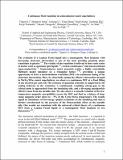| dc.contributor.author | Li, Tingxin | |
| dc.contributor.author | Jiang, Shengwei | |
| dc.contributor.author | Li, Lizhong | |
| dc.contributor.author | Zhang, Yang | |
| dc.contributor.author | Kang, Kaifei | |
| dc.contributor.author | Zhu, Jiacheng | |
| dc.contributor.author | Watanabe, Kenji | |
| dc.contributor.author | Taniguchi, Takashi | |
| dc.contributor.author | Chowdhury, Debanjan | |
| dc.contributor.author | Fu, Liang | |
| dc.contributor.author | Shan, Jie | |
| dc.contributor.author | Mak, Kin Fai | |
| dc.date.accessioned | 2022-04-12T18:26:35Z | |
| dc.date.available | 2022-04-12T18:26:35Z | |
| dc.date.issued | 2021 | |
| dc.identifier.uri | https://hdl.handle.net/1721.1/141862 | |
| dc.description.abstract | The evolution of a Landau Fermi liquid into a non-magnetic Mott insulator with increasing electronic interactions is one of the most puzzling quantum phase transitions in physics1-6. The vicinity of the transition is believed to host exotic states of matter such as quantum spin liquids4-7, exciton condensates8 and unconventional superconductivity1. Semiconductor moiré materials realize a highly controllable Hubbard model simulator on a triangular lattice9-22, providing a unique opportunity to drive a metal-insulator transition (MIT) via continuous tuning of the electronic interactions. Here, by electrically tuning the effective interaction strength in MoTe2/WSe2 moiré superlattices, we observe a continuous MIT at a fixed filling of one electron per unit cell. The existence of quantum criticality is supported by the scaling collapse of the resistance, a continuously vanishing charge gap as the critical point is approached from the insulating side, and a diverging quasiparticle effective mass from the metallic side. We also observe a smooth evolution of the magnetic susceptibility across the MIT and no evidence of long-range magnetic order down to ~5% of the Curie-Weiss temperature. This signals an abundance of low-energy spinful excitations on the insulating side that is further corroborated by the Pomeranchuk effect observed on the metallic side. Our results are consistent with the universal critical theory of a continuous Mott transition in two dimensions4,23. | en_US |
| dc.language.iso | en | |
| dc.publisher | Springer Science and Business Media LLC | en_US |
| dc.relation.isversionof | 10.1038/S41586-021-03853-0 | en_US |
| dc.rights | Creative Commons Attribution-Noncommercial-Share Alike | en_US |
| dc.rights.uri | http://creativecommons.org/licenses/by-nc-sa/4.0/ | en_US |
| dc.source | arXiv | en_US |
| dc.title | Continuous Mott transition in semiconductor moiré superlattices | en_US |
| dc.type | Article | en_US |
| dc.identifier.citation | Li, Tingxin, Jiang, Shengwei, Li, Lizhong, Zhang, Yang, Kang, Kaifei et al. 2021. "Continuous Mott transition in semiconductor moiré superlattices." Nature, 597 (7876). | |
| dc.contributor.department | Massachusetts Institute of Technology. Department of Physics | |
| dc.relation.journal | Nature | en_US |
| dc.eprint.version | Original manuscript | en_US |
| dc.type.uri | http://purl.org/eprint/type/JournalArticle | en_US |
| eprint.status | http://purl.org/eprint/status/NonPeerReviewed | en_US |
| dc.date.updated | 2022-04-12T17:50:44Z | |
| dspace.orderedauthors | Li, T; Jiang, S; Li, L; Zhang, Y; Kang, K; Zhu, J; Watanabe, K; Taniguchi, T; Chowdhury, D; Fu, L; Shan, J; Mak, KF | en_US |
| dspace.date.submission | 2022-04-12T17:51:07Z | |
| mit.journal.volume | 597 | en_US |
| mit.journal.issue | 7876 | en_US |
| mit.license | OPEN_ACCESS_POLICY | |
| mit.metadata.status | Authority Work and Publication Information Needed | en_US |
